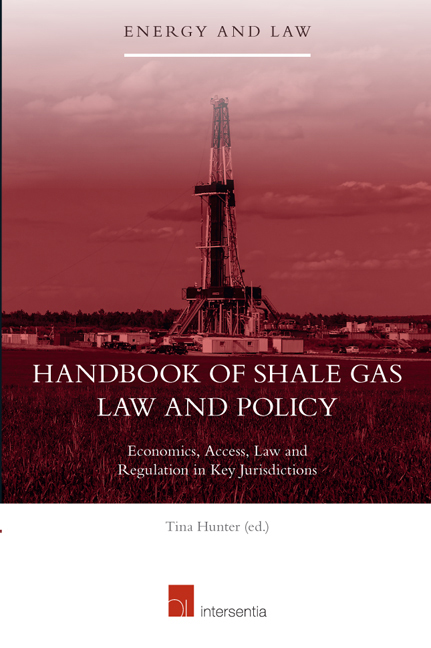Book contents
- Frontmatter
- Preface
- Contents
- List of Tables and Figures
- List of Authors
- Part I Overview and Introduction to Shale Gas Activities
- Part II Shale Gas Economics and Energy Security
- Part III Access to Shale Gas Resources
- Part IV Shale Gas Law and Regulation
- Regulating Hydraulic Fracturing
- Regulating Well Integrity
- The Environmental Challenges of Shale Gas Extraction
- An Overview of Shale Gas Law and Policy
- Shale Gas Law and Regulation in the United Kingdom
- Shale Gas Law and Regulation in North America
- Shale Gas Law and Policy in Australia
- Part V The Future of Shale Gas in the United Kingdom
- Index
The Environmental Challenges of Shale Gas Extraction
from Part IV - Shale Gas Law and Regulation
Published online by Cambridge University Press: 21 September 2018
- Frontmatter
- Preface
- Contents
- List of Tables and Figures
- List of Authors
- Part I Overview and Introduction to Shale Gas Activities
- Part II Shale Gas Economics and Energy Security
- Part III Access to Shale Gas Resources
- Part IV Shale Gas Law and Regulation
- Regulating Hydraulic Fracturing
- Regulating Well Integrity
- The Environmental Challenges of Shale Gas Extraction
- An Overview of Shale Gas Law and Policy
- Shale Gas Law and Regulation in the United Kingdom
- Shale Gas Law and Regulation in North America
- Shale Gas Law and Policy in Australia
- Part V The Future of Shale Gas in the United Kingdom
- Index
Summary
INTRODUCTION: THE CHALLENGE OF NEW TECHNOLOGIES FOR ENVIRONMENTAL LAW
The introduction of new, industry-wide technologies have nearly always presented challenges to regulation and especially environmental regulation. Two contemporary examples are the utilisation of genetically-modified organisms (GMOs) in the farming and food industries, and the development of nanotechnology for a whole range of industrial applications. In this sense, the development of shale gas extraction technology is an interesting mixture of both known and unknown technologies within the petroleum industry, of which the ‘unknown’ aspects have particular implications from an environmental regulation perspective. Both ‘shale gas’ and its extraction modes have been defined in official terms within several jurisdictions. Perhaps the most succinct description of both the resource itself and the methods for its extraction is as follows: ‘Shale gas is natural gas that is trapped within fine-grained sedimentary rock called shale. Shale contains tiny pores in which natural gas has become trapped over time. It is accessed and extracted through a process called horizontal drilling and hydraulic fracturing.’ Th us, recent technological advances are making shale gas reserves increasingly accessible and their recovery more economically feasible, which in turn has brought this burgeoning sector of the petroleum industry to the forefront of regulatory attention at the present time.
The process of exploring and hydraulically fracturing for shale gas broadly involves three phases, namely, exploration, production, and abandonment, which consist of, inter alia, the following activities: (1) developing a well pad and sinking a borehole to the target rock formations; (2) hydraulically fracturing the rock through the pressurised injection of a mixture of water, sand and chemicals to allow gas to come to the surface; some of the used fracturing fluid will flow back and this will now potentially contain natural gas (predominantly methane), salts, metals as well as naturally occurring radioactive materials (NORM); (3) the treatment and/or disposal of waste flowback liquids that may be temporarily held on-site in secure storage; at the exploratory stage any gases produced may be flared or vented to atmosphere, subject to safety and environmental controls; and finally (4) decommissioning or suspending the borehole. All of these activities raise environmental challenges for the relevant regulatory institutions overseeing them.
- Type
- Chapter
- Information
- Handbook of Shale Gas Law and PolicyEconomics, Access, Law and Regulation in Key Jurisdictions, pp. 237 - 260Publisher: IntersentiaPrint publication year: 2016

